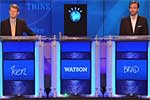


ChessBase 17 - Mega package - Edition 2024
It is the program of choice for anyone who loves the game and wants to know more about it. Start your personal success story with ChessBase and enjoy the game even more.
![]()
Facing certain defeat at the hands of a room-size I.B.M. computer on Wednesday evening, Ken Jennings, famous for winning 74 games in a row on the TV quiz show, acknowledged the obvious. “I, for one, welcome our new computer overlords,” he wrote on his video screen, borrowing a line from a “Simpsons” episode. For I.B.M., the showdown was not merely a well-publicized stunt and a $1 million prize, but proof that the company has taken a big step toward a world in which intelligent machines will understand and respond to humans, and perhaps inevitably, replace some of them.
In its “Jeopardy!” project, I.B.M. researchers were tackling a game that requires not only encyclopedic recall, but also the ability to untangle convoluted and often opaque statements, a modicum of luck, and quick, strategic button pressing. More than anything, the contest was a vindication for the academic field of computer science, which began with great promise in the 1960s with the vision of creating a thinking machine and which became the laughingstock of Silicon Valley in the 1980s, when a series of heavily financed start-up companies went bankrupt.
For I.B.M., the future will happen very quickly, company executives said. On Thursday it plans to announce that it will collaborate with Columbia University and the University of Maryland to create a physician’s assistant service that will allow doctors to query a cybernetic assistant. The company also plans to work with Nuance Communications Inc. to add voice recognition to the physician’s assistant, possibly making the service available in as little as 18 months. I.B.M. executives also said they are in discussions with a major consumer electronics retailer to develop a version of Watson, named after I.B.M.’s founder, Thomas J. Watson, that would be able to interact with consumers on a variety of subjects like buying decisions and technical support.
The Watson Jeopardy show
Part 2 of the Jeopardy report
In 1997, Deep Blue, another computer built by I.B.M., defeated the world chess champion, Garry Kasparov, in a six-game match. At the time, it was considered a stunning achievement and a significant step forward in the field of artificial intelligence. Some people said that a new era would be ushered in, one in which computers would perform many tasks — like air traffic control — that it once seemed only humans could do. That era has not quite materialized.
But almost 14 years later, chess programs running on an average desktop computer can play better than Deep Blue, making its victory no longer seem as implausible. And while the research that went into making Deep Blue has not itself transformed society, the lessons from designing and building it have had practical applications, said Murray S. Campbell, one of Deep Blue’s developers, who still works at I.B.M.
Playing chess was a “deep computing” problem, Dr. Campbell said, the kind that involves processing and analyzing large amounts of data. Based on what it learned from Deep Blue, I.B.M. created a Deep Computing Institute to analyze and solve complex computing problems, like those posed by credit card transactions, telephone call centers and weather analysis.
What the researchers who created Deep Blue did not even try to do was to develop a system that could really identify, parse and mimic human behavior. “We didn’t know what to do with language and speech and vision and so on,” Dr. Campbell said. “It was so hard. Where Deep Blue left off is where Watson picks up. “Watson is finally tackling these real world issues,” Dr. Campbell said. “It is tackling it head-on and not trying to avoid it.”
Part of what makes that possible is that Watson is much more powerful than Deep Blue. It has 2,800 microprocessors; Deep Blue had 30 general-purpose processors and 480 custom ones. Watson can calculate up to 80 teraflops, or 80 trillion operations, a second, which is about 100 times faster than Deep Blue.
Still, what Watson does is not all that dissimilar from what Deep Blue did, Dr. Campbell said. “We don’t claim that Watson is thinking in the way people think. It is working on a computational problem at its core.” Deep Blue never played again. Part of it is now in the Smithsonian. “We’d accomplished what we set out to do,” Dr. Campbell said.